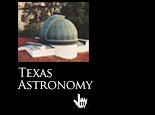Sunday, October 16th
|
7:00pm:
|
Reception (Appetizers and Drinks)
Mansion at Judges Hill
(website)
Map & Parking
(pdf)
1900 Rio Grande Blvd., (512) 495-1800
|
Monday, October 17th
|
8:45:
|
Welcoming Statements
Mary Ann Rankin, Dean, College of Natural Sciences
Don Winget, Chair, Department of Astronomy
|
|
Session I, ACES 2.302 - Judit Györgyey Ries, Chair,
bio
|
9:00-9:40:
|
Asteroids, Kuiper Belt Objects, Comets, Satellites and the Formation of Our Solar System
Scott Sheppard, Carnegie DTM
abstract
bio
|
9:40-10:20:
|
What do Multiple Planet Systems Teach Us About Planet Formation?
Eric Ford, Berkeley
abstract
bio
|
10:20-11:00:
|
Coffee & Posters, ACES 2.402
|
11:00-11:40:
|
Massive Star Formation: A Tale of Two Theories
Mark Krumholz, Princeton
abstract
bio
|
11:40-12:20:
|
Probing Chemistry During Star and Planet Formation
Jackie Kessler-Silacci, UT
abstract
bio
|
12:20-2:00:
|
Lunch* & Posters
*includes a 1 hour Q&A session
with
postdoc speakers and graduate students
|
|
Session II, ACES 2.302 - Michael Siegel, Chair,
bio
|
2:00-2:40:
|
Disks Around Young Stars
Christine Chen, NOAO
abstract
bio
|
2:40-3:20:
|
Local Interstellar Medium
Seth Redfield, UT
abstract
bio
|
3:20-4:00:
|
Coffee & Posters, ACES 2.402
|
4:00-4:40:
|
Large-scale Structures in the ISM
Naomi McClure-Griffiths, ATNF
abstract
bio
|
4:40-5:40:
|
Panel Discussion
|
5:40-6:30:
|
Posters, Informal Discussion
|
7:30pm:
|
Conference Dinner at Fonda San Miguel
Map & Parking
(pdf)
2330 W. North Loop, (512) 459-4121
|
Tuesday, October 18th
|
|
Session III, ACES 2.302 - Martin Landriau, Chair,
bio
|
9:00-9:40:
|
Stellar Abundances: Recent and Foreseeable Trends
Carlos Allende-Prieto, UT
abstract
bio
|
9:40-10:20:
|
Black Holes
Jon Miller, Univ. Michigan
abstract
bio
|
10:20-11:00:
|
Coffee & Posters, ACES 2.402
|
11:00-11:40:
|
Jets and Accretion in Microquasars and in AGN
Sera Markoff, MIT
abstract
bio
Black holes from stellar to galactic scales are observed to accrete
material fromtheir environments and, via an as yet unknown mechanism,
produce jets of outflowing plasma. In X-ray binaries (XRBs), the
systems display radically different radiative properties depending on
the amount of captured gas reaching the event horizon. These modes
of behavior (one of which includes "microquasars") correspond to
actual physical changes in the environment near the black hole, and
can occur on timescales of days to weeks. Some of this behavior
should hold true for active galactic nuclei (AGN) if the underlying
physics scales with central mass and accretion power, as would be
expected if black holes "have no hair". However, the timescales on
which changes occur should be inversely proportional to the mass.
Recent studies support that this scaling applies in some cases,
opening the way for comparisons of time-dependent behavior in
microquasars to some classes of AGN zoology. In this distinctly
jet-biased review, I will summarize our current understanding of
accretion and outflow in these systems, and present some of the
newest progress addressing unanswered questions about the nature of
the accretion flows, jet formation and jet composition.
|
|
11:40-12:20:
|
Galactic Chemical Evolution
Yeshe Fenner, CfA
abstract
bio
|
12:20-2:00:
|
Lunch* & Posters
*includes a 1 hour Q&A session
with
postdoc speakers and graduate students
|
|
Session IV - Niv Drory, Chair,
bio
|
2:00-2:40:
|
The N-body Approach to Disk Galaxy Evolution
Victor Debattista, Univ. Washington
abstract
bio
|
2:40-3:20:
|
Galaxy Formation
Eric Gawiser, Yale
abstract
bio
|
3:20-4:00:
|
Coffee & Posters, ACES 2.402
|
4:00-4:40:
|
Lyman-alpha Forest as a Cosmological Probe
Matteo Viel, IoA
abstract
bio
|
4:40-5:40:
|
Panel Discussion
|
5:40-6:00:
|
Concluding Remarks
David Lambert, Director, McDonald Observatory
Frank Bash, Professor, Department of Astronomy
|
6:00-6:30:
|
Posters, Informal Discussion
|
Evening:
|
Informal "Night on the Town"
|


